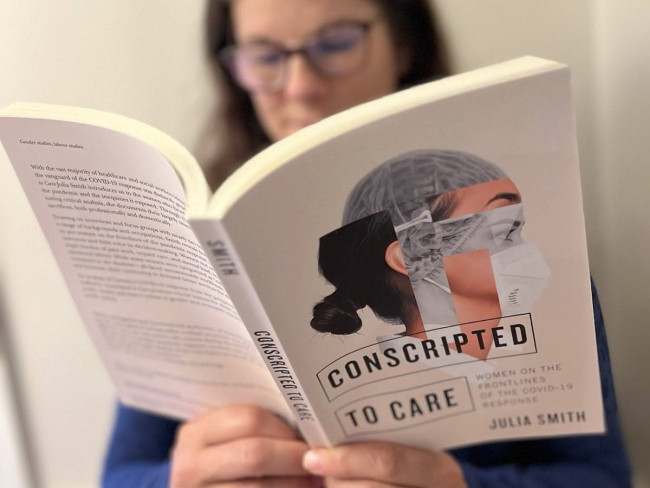
The frontline of the COVID-19 response was distinctly gendered, with women making up the majority—75 per cent—of healthcare workers in Canada and taking on the bulk of caregiving at home and in the community. Several studies by Simon Fraser University (SFU) professor Julia Smith document both their contributions and sacrifices to Canada’s pandemic response.
In her new book published last month by McGill-Queen's University Press, Smith shares stories from women healthcare workers, educators and parents whose home and work lives were transformed by the pandemic. Conscripted to Care: Women on the Frontlines of the COVID-19 Response is the culmination of extensive research Smith has conducted over the past several years.
A professor in the Faculty of Health Sciences at SFU, a Michael Smith Health Research BC Scholar and a faculty member of the Centre for Gender and Sexual Health Equity, Smith’s research centres around the relationship between social and health inequities, as well as the healthcare workforce and care economy. She has worked with health and development programs in Canada, Europe and Africa using mixed research methods and an intersectional feminist lens to better understand the connection between public policy and health outcomes.
Smith is also member of the Gender and Public Health Emergencies Working Group, and studied the gender dynamics of the pandemic response. She has published research on the challenges faced by women healthcare providers, the relationship between the increase in women's unpaid care work and falling employment, and the impacts of lockdown on the increase in gender-based violence. Her article, Canada’s health-care crisis is gendered: How the burden of care falls to women, was recently published in The Conversation.
In Conscripted to Care, Smith draws on interviews and focus groups with nearly two hundred women from a range of backgrounds and occupations. She observed that women shouldered not only the triple burden of paid work, unpaid care and mental load, but also increased emotional labour. All faced unsustainable workloads, moral distress and burnout while continuing to demand better services for those in their care.

Health Sciences professor Julia Smith’s new book analyses Canada’s COVID-19 response from the perspective of those who staffed it.
We spoke with Julia Smith about her research.
Several of your studies discuss the moral distress felt by women healthcare workers. Can you describe what moral distress refers to and how the pandemic caused it?
Moral distress occurs when external constraints prevent you from providing the care you feel is ethically required. In the book I write about how, during the pandemic, long-term care providers experienced moral distress when they did not have enough time to give residents baths, and nurses experienced moral distress when they were delayed in helping a critically ill patient because they had to put on personal protective equipment (PPE). Parents also described moral distress related to manage both increased work and childcare demands. Because moral distress can lead to poor health and burnout, it can have long term impacts on women’s work and wellbeing.
Your research found that in Canada, more women than men died from COVID-19. Can you explain why? In what other ways did the pandemic affect women differently than men?
That statistic comes from Statistics Canada and there is not a clear answer as to why more women than men died. It likely has to do with age—the majority of those who died were also older adults and that age group includes more women than men. It may also do to the fact that most frontline professions—at increased risk of COVID infection—primarily employ women. For example, 75 per cent of healthcare providers in Canada are women.
Where we see the most notable impacts on women is the secondary effects of the pandemic. For example, women not only lost more jobs during the first few months of the pandemic, compared to men, it took men only six months to regain pre-pandemic employment levels, while it took women’s employment 13 months to rebound.
Regarding the large number of women who had to leave the workforce to provide childcare and/or care for a family member for other preseasons, have employment statistics returned to pre-pandemic levels?
As per my previous answer, yes, employment statistics have returned to pre-pandemic levels. In fact, women’s employment has now surpassed 2019 levels.
I would add that it is important to recognize women’s contributions to Canada’s economic recovery, including those contributions that are not captured in formal employment statistics. It is the unpaid care work that women are most likely to do in the home—cleaning, cooking, childcare, eldercare, etc.—that enabled others to return to work, mitigated education interruptions, and filled gaps when health and social services were closed.
Has the pandemic led to policy change in any areas that you study? Did you see any positive progress made?
I think the pandemic was a catalyst for policy change around childcare, as we all became painfully aware of how impossible it was to work without it. The increased investments at the federal and provincial level are already having positive impacts in terms of reducing costs. Much more needs to be done to improve accessibility as many parents still cannot access childcare. Many parents are on massive waitlists for afterschool care for their children, myself included.
During the pandemic there was notable investment in organizations addressing gender-based and other forms of violence, which was great. The organizations I spoke to described how these resources enabled them to reach more people in need and provided streamlined funding. There is concern that this funding is now tapering off, which means these organizations will lose capacity to respond to future crises.
What more should governments be doing to keep all citizens equally safe, sheltered and secure?
We are still in a healthcare crisis, with healthcare workers and allied professions (which all are women-dominated) understaffed and burnt out. Much of what I write about in the book, related to moral distress, burnout and feeling undervalued, still rings true even after the pandemic. Governments need to increase investments in both the health system and care economy that supports it. This includes recognizing this work as structured by gender inequalities and seeking to rectify these by, for example, addressing gender pay gaps, ensuring the representation of under-represented groups in leadership, improving sick pay and benefits in feminized professions like long-term care, and much more.
To order Conscripted to Care: Women on the Frontlines of the COVID-19 Response, visit McGill-Queens University Press.
For more about Julia Smith’s work visit genderandcovid-19.org, read this publication in SFU News and Smith’s recent article in The Conversation Canada.
This research was supported by The Canadian Institutes for Health Research, the B.C. Women’s Health Foundation and Canada’s Social Sciences and Humanities Research Council.
SFU's Scholarly Impact of the Week series does not reflect the opinions or viewpoints of the university, but those of the scholars. The timing of articles in the series is chosen weeks or months in advance, based on a published set of criteria. Any correspondence with university or world events at the time of publication is purely coincidental.
For more information, please see SFU's Code of Faculty Ethics and Responsibilities and the statement on academic freedom.